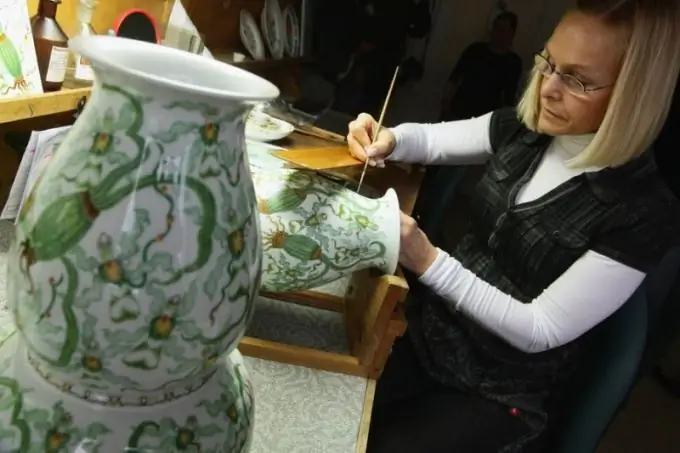It is most convenient to paint porcelain using overglaze paints. It is a powder, you can find it in art stores, and it consists of metal oxides and flux.

Instructions
Step 1
In this case, the flux plays the role of a fixer, and the color of the paint is determined by metal oxides. Then, under the influence of high temperatures, the fluxes are melted and the oxides are welded to the porcelain. Dry paints are mixed with turpentine oil on a palette before painting - and the paint acquires color. It is best to use glass as a palette, if it is transparent, then you can put a white sheet of paper underneath to compare colors. A spatula for mixing powder with turpentine oil should be made of plastic or horn - other materials can react with turpentine.
Step 2
Turpentine oil is made independently from turpentine turpentine used in oil painting. Turpentine is poured into a saucer and left in a warm place. After about 10 days, it thickens and turns into turpentine oil. The turpentine itself will also be needed in the work if you need to make a certain color a little thinner.
Step 3
It is best to apply the drawing whitewashed, without using preliminary auxiliary lines. If the composition is complex, you can use an ordinary pencil. On porcelain greased with turpentine, it draws well and does not slip if you wait for the turpentine layer to dry. It is most convenient to paint a plate or saucer by holding them in your left hand (for right-handers). You can put a plate on the table and arrange your hand with a brush on a special stand or bench. To carry out a clear and even layering - strips along the edge of the plate - use a special rotating instrument, a shutter. In order to paint tiles or objects similar to them in shape, use a wooden stand in the form of an inclined mini-easel.
Step 4
The difficulty of painting with these paints on ceramics is that after firing, the colors can change in an unpredictable way. Anticipation of the expected color effects becomes possible only after many years of practice, and beginners most often use reference tiles for this. They are made from all available paints, which are applied to one tile with small strokes in a convenient sequence. The tile is fired in a muffle furnace, and after cooling down, one more smear is applied next to each smear, which is no longer fired - the difference is clearly visible and always at hand. In the same way, color mixing is tested - vertical stripes are drawn and then overlapping horizontal stripes. They burn and look at pure colors and at mixed ones - at the intersections. Each test tile will only be correct with a specific batch of paint. Paints with the same name, made by different factories, can vary greatly.






